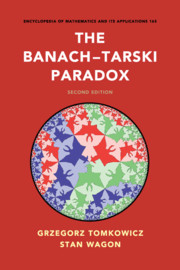Book contents
- Frontmatter
- Dedication
- Epigraph
- Contents
- Foreword
- Addendum to the Foreword
- Preface
- Part One Paradoxical Decompositions, or the Nonexistence of Finitely Additive Measures
- Part Two Finitely Additive Measures, or the Nonexistence of Paradoxical Decompositions
- Appendices
- A Euclidean Transformation Groups
- B Jordan Measure
- C Graph Theory
- Bibliography
- List of Symbols
- Index
C - Graph Theory
from Appendices
Published online by Cambridge University Press: 05 June 2016
- Frontmatter
- Dedication
- Epigraph
- Contents
- Foreword
- Addendum to the Foreword
- Preface
- Part One Paradoxical Decompositions, or the Nonexistence of Finitely Additive Measures
- Part Two Finitely Additive Measures, or the Nonexistence of Paradoxical Decompositions
- Appendices
- A Euclidean Transformation Groups
- B Jordan Measure
- C Graph Theory
- Bibliography
- List of Symbols
- Index
Summary
A graph consists of a vertex set V and an edge set E, where each edge, written consists of two vertices; a vertex in an edge is said to be a neighbor of the other vertex. A simple graph is one in which there are no multiple edges (any edge occurs at most once in E) and no loops. In this book, graph means simple graph. If multiple edges are allowed, the term multigraph is commonly used, though in this book we will say only that multiple edges are allowed. If the edges have a direction, then the graph is called a directed graph and edges are written. This book makes much use of infinite graphs, where the vertex set is infinite. The degree of a vertex is the number of edges containing it.
A path in a graph is a (possibly infinite) sequence of vertices such that each is an edge. A cycle is a path that is finite and whose last vertex is the same as the first. The vertices in a path or cycle are generally assumed to be distinct (except for the first and last vertex of a cycle). A tree is a graph with no cycles. A graph is connected if for every two vertices there is a path from one to the other. Any graph can be partitioned into maximal connected subgraphs, called the connected components.
A graph is k-regular if all vertices have degree k. A finite graph that is 2- regular can be partitioned into disjoint cycles. A graph in which every vertex has degree 1 or 2 splits into cycles and paths. A degree-1 vertex is often called a leaf.
A graph is locally finite if every vertex has finite degree; for such a graph, any connected component is countable.
A bipartite graph is one whose vertices split into A and B so that every edge has one end in A and the other in B. It is easy to prove that a graph is bipartite iff every cycle has even length.
A matching in a graph is a set of disjoint edges. A perfect matching is one whose ends cover all vertices; a graph with an odd number of vertices cannot have a perfect matching. We care most about infinite graphs, because matchings can yield equidecomposabilty of sets.
- Type
- Chapter
- Information
- The Banach–Tarski Paradox , pp. 322 - 324Publisher: Cambridge University PressPrint publication year: 2016



